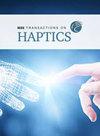前臂的压力刺激和时空错觉
IF 2.4
3区 计算机科学
Q2 COMPUTER SCIENCE, CYBERNETICS
引用次数: 0
摘要
要利用压力设计复杂的可穿戴触觉界面,我们必须探索如何充分发挥压力刺激的潜力。触觉错觉,如明显的运动和明显的位置,可以是其中的一部分。如果这些幻觉可以通过压力诱发,那么触觉模式的复杂性就会增加,而无需增加致动器的数量或组合不同类型的致动器。我们使用一个带有多个单独控制的麦基本致动器的气动套筒,对前臂的压力刺激进行了两次心理物理实验。在实验 1 中,我们发现两个同时呈现的刺激物在距离达 61 毫米时会发生空间整合。在实验 2 中,我们发现在一定的时间参数范围内,不同的压力刺激可以引起明显的运动。这些结果清楚地显示了压力刺激在体感系统中的时空整合。我们将结合振动和无毛皮肤机械感受器的效应来讨论这些发现。本文章由计算机程序翻译,如有差异,请以英文原文为准。
Pressure Stimuli and Spatiotemporal Illusions on the Forearm
To design complex wearable haptic interfaces using pressure, we have to explore how we can use pressure stimuli to theirfull potential. Haptic illusions, such as apparent motion and apparent location, can be a part of this. If these illusions can be evoked with pressure, haptic patterns can increase in complexity without increasing the number of actuators or combining different types of actuators. We did two psychophysical experiments with pressure stimuli on the forearm using a pneumatic sleeve with multiple, individually controlled McKibben actuators. In Experiment 1, we found that spatial integration of two simultaneously presented stimuli occurred for distances up to 61 mm. In Experiment 2, we found that apparent motion can be elicited with distinct pressure stimuli over a range of temporal parameters. These results clearly show spatio-temporal integration in the somatosensory system for pressure stimuli. We discuss these findings in relation to effects found for vibration and the mechanoreceptors in the glabrous skin.
求助全文
通过发布文献求助,成功后即可免费获取论文全文。
去求助
来源期刊

IEEE Transactions on Haptics
COMPUTER SCIENCE, CYBERNETICS-
CiteScore
5.90
自引率
13.80%
发文量
109
审稿时长
>12 weeks
期刊介绍:
IEEE Transactions on Haptics (ToH) is a scholarly archival journal that addresses the science, technology, and applications associated with information acquisition and object manipulation through touch. Haptic interactions relevant to this journal include all aspects of manual exploration and manipulation of objects by humans, machines and interactions between the two, performed in real, virtual, teleoperated or networked environments. Research areas of relevance to this publication include, but are not limited to, the following topics: Human haptic and multi-sensory perception and action, Aspects of motor control that explicitly pertain to human haptics, Haptic interactions via passive or active tools and machines, Devices that sense, enable, or create haptic interactions locally or at a distance, Haptic rendering and its association with graphic and auditory rendering in virtual reality, Algorithms, controls, and dynamics of haptic devices, users, and interactions between the two, Human-machine performance and safety with haptic feedback, Haptics in the context of human-computer interactions, Systems and networks using haptic devices and interactions, including multi-modal feedback, Application of the above, for example in areas such as education, rehabilitation, medicine, computer-aided design, skills training, computer games, driver controls, simulation, and visualization.
 求助内容:
求助内容: 应助结果提醒方式:
应助结果提醒方式:


